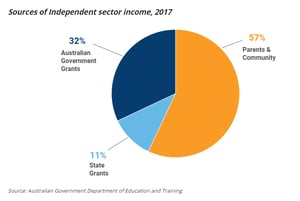Non-government schools are funded via a number of sources-most notably, school fees, per capita funding from Commonwealth, state and territory governments, occasional donations or bequeaths and some community fundraising.
Each year, school governing bodies develop their annual budget for the following year and, among a myriad of other financial restraints, collectively struggle with one big issue- how to keep school fee increases to a minimum while still providing excellent education and care, and still producing a balanced budget in the face of rising human resource, utility, building and general educational costs.
There is no doubt that rising teacher salaries has been a major factor in school fee increases. This of course, then affects the “Education CPI”, which is generally a few percentage points above the “All groups CPI”. Each time a school increases its fees it ends up with a new baseline that only goes up from there.
Edstart chief executive Jack Stevens has noted that “It's very clear that fee inflation is driven primarily by the increasing cost of school operations, and in some cases, a decline in government funding”.
For low-fee schools, and they represent the bulk of the non-government school sector, any fee increase that is likely to result in parents no longer being able to afford to send their child to those schools is a serious risk, where even the loss of a single child can result in a negative cashflow situation by the end of the year.
The Independent Schools Council of Australia (ISCA) notes on its website “It is estimated that the willingness and commitment of parents to pay fees for Independent schooling saves governments approximately $4.5 billion a year, based on a calculation of the increased funding that would be required if all Independent school students attended government schools where they would be fully publicly funded.  Through fees and private contributions, the families of students in Independent schools contribute over $6.1 billion to the annual total investment in education”. In addition, ISCA notes that most of the capital development in schools, 90 per cent of the annual average investment, is sourced privately.
Through fees and private contributions, the families of students in Independent schools contribute over $6.1 billion to the annual total investment in education”. In addition, ISCA notes that most of the capital development in schools, 90 per cent of the annual average investment, is sourced privately.
A recent Financial Review article stated that “private-school parents face fees as high as $84,221 a year by 2040 meaning even double-income families will find it hard to afford independent education. But even if the Education CPI rate flattens, school boards are "woefully under prepared" for changing patterns of demand meaning some schools may have to abandon the traditional cricket pitches, rugby ovals and swimming pools and switch to shared facilities, remote sport locations and even shared teachers”.
John Simpson, who was a board member at Scotch College in Melbourne for 16 years, said “the realisation of $84,221 fees would terrify parents”. He goes on to say that, at that cost, “only the super wealthy will be able to afford” that level of fees which is “very bad for diversity in education and for choice”. It would also be bad for schools as they will lose a large portion of their potential ‘customer base’.
According to the article, the $84,221 projection is based on the 10-year trend in the government's Education CPI index based on a typical present-day fee of $34,260 for a year 12 student. For Catholic schools the 2040 projection is $22,672, much less than other top-tier independent schools but more than double the current Catholic school figure.
Strategic Planning
John Simpson said he raised the issue because too many non-government school principals were reticent about long-term cost trends. He went on to note that boards and management needed to be more open to talking about change because cost pressures would force reform anyway. "Private schools get swamped by the operational at the expense of the strategic. They have a strategy day once a year. That's not sufficient to grapple with the immense challenges they face."
Many schools develop five-year strategic plans, with strategically-thinking boards basing their strategic plan on their strategic risks. Others, unfortunately, still use ‘motherhood’ type statements that do not link to strategic risks and therefore their plans are difficult to monitor and show achievement of outcomes.
Of greatest concern is if school governing bodies do NOT visit their strategic plan at least every twelve months to not only check to see if milestones are being reached, but to ensure that the risks that were identified have been or are still being addressed. In the rapidly changing Australian education environment, schools need to be increasingly agile and prepared to adapt to change. One positive action is to regularly analyse your strategic plan to ensure that you are mitigating against the current and future educational risks and that you remain fully aligned to your school community’s needs.
Significant school changes, such as adding on a pre-kindergarten class or perhaps Year 13, would also impact the strategy and operations of your school, prompting a need to assess new risks and implement or amend controls to effectively mitigate the new risk exposures. Boards or executive staff, in their desire to bring about strategic change by focusing only on the risks within their Strategic Plan, can neglect adequate revision of internal controls to address previously undiscussed and identified risks.
When implementing strategic objectives, the school governing body should not only consider the impact and changes to its operating model but also how effectively the strategy has been executed. Basically, boards should be questioning whether any defined strategy was altered or has evolved during the actual execution.
In the CompliSpace White Paper, 12 Key Risks for School Boards to Consider in 2019, it was noted that a key component of effective board performance is ensuring that sufficient board time and resources are directed towards strategy issues.
McKinsey & Company in “High performing boards: what’s on their agenda?”, suggests that low performing boards focus on “the basics” – compliance, financial reports etc. High performing boards do the basics but spend much more time on strategy - evaluating the allocation of resources, adjusting strategy based on changing conditions, assessing whether strategy stays ahead of the trends, debating strategic alternatives and engaging with innovation. The most likely reason that low impact boards only spend time on “the basics” is that they do not have agendas (and associated board reports) that regularly cover key strategic discussions, enterprise risk management, performance management etc. However, if strategy discussions are not directed and managed well, boards can easily head off on tangential discussions (particularly focusing on operational issues) or make decisions that are impractical or that do not fit within current resource capabilities.
In Summary
The crucial question is, however, what are boards doing to plan for the ever increasing costs associated with running a school and the resulting increases in school fees that have to be passed on to parents if government funding does not increase to pick up the shortfall?
The figure of $84,221 seems to be so astronomically large, that it may been seen by some as little more than sensationalism. However, there is no doubt that school fees rise on an almost annual basis, due to increases in standard expenditure, to enable schools to remain financially viable.
Regardless of the exact figure that has been quoted, the stark reality is that school governing bodies need to plan effectively for risks. A failure to manage school fee increases that result in losses of student numbers is a serious risk that all boards need to discuss and mitigate against or we may find that $84,221 is stark realism and not sensationalism!




